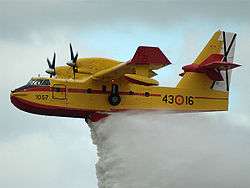Military Emergencies Unit
| Military Emergencies Unit | |
|---|---|
 | |
| Active | 11 April 2006 – present |
| Country | Spain |
| Allegiance | King Felipe VI |
| Branch | Spanish Armed Forces |
| Role | Emergency management |
| Size | 3,987 (2008) |
| Part of | Ministry of Defence |
| Headquarters | Torrejón Air Base |
| Motto(s) | Para servir (To serve) |
| Colors | Yellow |
| March | "Himno UME" |
| Anniversaries | October 7 |
| Website | www.mde.es/ume |
| Commanders | |
| Commander in Chief | King Felipe VI |
| Unit Commander | Lt General José Emilio Roldán Pascual |
| Aircraft flown | |
| Bomber | Canadair CL-215 |
| Utility helicopter | Eurocopter EC135 |
| Transport | Eurocopter AS532 Cougar |
The Military Emergencies Unit (Spanish: Unidad Militar de Emergencias, UME; IPA: [uniˈðað miliˈtar ðe emerˈxenθjas]) is a branch of the Spanish Armed Forces responsible for providing disaster relief throughout Spain mainly, and abroad if required. It is the newest branch of the Spanish Armed Forces.
History
The decision to create the Military Emergencies Unit was agreed upon at a cabinet meeting of the Zapatero administration on October 7, 2005.[1] This was enacted in law by the Real Decreto 416/2006 (Royal Decree 416/2006) on April 11, 2006.[2]
Missions
- Intervention during emergencies that have their origin in natural hazards; among these are floods, spill-overs, earthquakes, land slides, large snow storms and other adverse weather conditions.
- Intervention fighting forest fires.
- Intervention during emergencies derived from technological hazards; among which are chemical, nuclear, radiological and biological hazards
- Intervention during emergencies as a consequence of terrorist attacks or illicit or violent acts, including those acts against critical infrastructures, dangerous installations or with nuclear, biological, radiological or chemical agents.
- Intervention during situations of environmental contamination.
- Intervention during any other emergency deemed appropriate by the Prime Minister of Spain.
Organisation
The UME consists of Headquarters (Unidad de Cuartel General, UCG), five emergency intervention battalions (Batallon de Intervención en Emergencias, BIEM), a support regiment (Regimiento de Apoyo a Emergencias, RAEM) and an aerial group (Agrupación de Medios Aéreos, AGRUMEDA)
| Name | Headquarters | Areas Served |
|---|---|---|
| BIEM I | Torrejón de Ardoz Air Base | Ávila, Segovia, Madrid, Cáceres, Guadalajara, Cuenca, Ciudad Real, Toledo, Cáceres |
| BIEM II | Morón Air Base | Badajoz, Huelva, Sevilla, Cádiz, Málaga, Córdoba, Jaén, Granada, Jaén, Ceuta, Melilla, Fuerteventura, Gran Canaria, La Gomera, El Hierro, Lanzarote, La Palma, Tenerife |
| BIEM III | Bétera | Albacete, Murcia, Alicante, Valencia, Castellón, Balearic Islands |
| BIEM IV | Zaragoza Air Base | Biscay, Guipúzcoa, Álava, La Rioja, Soria, Navarre, Zaragoza, Huesca, Teruel, Lleida, Tarragona, Barcelona, Girona |
| BIEM V | San Andrés del Rabanedo | Pontevedra, A Coruña, Lugo, Ourense, Asturias, Cantabria, León, Zamora, Salamanca, Valladolid, Palencia, Burgos |
| Name | Headquarters |
|---|---|
| UCG | Torrejón de Ardoz Air Base |
| RAEM | |
| AGRUMEDA | |
Gallery
- Suzuki DRZ 400 S.
- Santana Aníbal.
- Military Police vehicle.
- Communications vehicle Mérida.

- URO M3-24.14. based BFP 40-106 J-1884 firetruck
_(15352038639).jpg) Mobile command center.
Mobile command center.

See also
References
- ↑ "RESOLUCIÓN de 19 de enero de 2006, de la Subsecretaría, por la que se da publicidad al Acuerdo de Consejo de Ministros por el que se crea la Unidad Militar de Emergencias (UME).". Boletín Oficial del Estado.
- ↑ "Real Decreto 416/2006, de 11 de abril, por el que se establece la organización y el despliegue de la Fuerza del Ejército de Tierra, de la Armada y del Ejército del Aire, así como de la Unidad Militar de Emergencias.". Boletín Oficial del Estado.